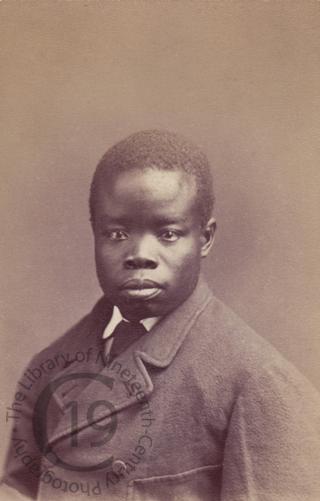
Jacob Wainwright
A carte-de-visite portrait of the Jacob Wainwright, a companion of the missionary and explorer David Livingstone. Unlike Chuma and Susi, who had also accompanied their former master’s embalmed body on its 1500-mile journey to the coast, Jacob Wainwright continued with the coffin on its sea voyage to England and was present at Livingstone’s funeral in Westminster Abbey on 18 April 1874. He rode in the second carriage behind the hearse, along with Livingstone’s friend William Frederick Webb, the owner of Newstead Abbey; the Scottish physician, naturalist and explorer John Kirk; Livingstone’s close personal friend Lieutenant-Colonel Sir Thomas Steele; and Kalulu, Henry Morton Stanley’s young African attendant.
Wainwright clearly generated some interest among the British public. A few days later the following article appeared in The Times, written by the missionary William Salter Price: ‘Sir – Will you allow me, in a few words, to give an answer to the many inquiries made to me respecting Jacob Wainwright, the African youth who accompanied the remains of the Dr Livingstone to England? He was rescued from slavery some years ago, and placed for education in the African Asylum, one of the institutions of the Church Missionary Society in their mission station of Nasik, in the Bombay Presidency, which was under my charge. When the Relief Expedition was sent out from England by the Royal Geographical Society in the early part of 1872, Jacob Wainwright and five others volunteered to join it. […] When the Expedition unhappily fell through, and the leaders of it returned, Jacob and his companions elected to join the party of native soldiers who were despatched from Zanzibar by Mr Stanley in charge of provisions for Dr Livingstone. They met the Doctor at Unyanyembe, and remained with him through all his wanderings to the day of his death. After that sad event, Jacob commenced keeping a diary, and continued it for nine weary months, during which they were working their way to the coast, carrying with them the mortal remains of their late master. It is a most interesting record of their journeyings, and contains observations on the natural features of the various countries through which they passed, and some notice of the customs of the different tribes of people with whom they came in contact.
‘This diary will shortly be given to the public, together with a variety of information which Jacob is able to furnish in regard to the events which have occurred since he joined the lamented traveller two years ago at Unyanyembe. […] I may add that Jacob has been brought home at the expense of the Church Missionary Society, and that after he has received some further training and education in England, his desire is to return to his own country, to be employed as a teacher in the Society’s East African Mission’ [The Times, 22 April 1874].
Photographed by Elliott and Fry of London.
Code: 126034




